

Published on Wednesday, July 22, 2020 by Common Dreams As Planet Edges Closer to Multiple Climate Tipping Points, Scientists Identify First Active Methane Gas Leak in Antarctica "It is not good news." by Julia Conley, staff writer. Scientists have for the first time identified an active leak of methane gas from the sea floor in Antarctica, increasing the possibility that the planet is close to one of the "tipping points" that would put the impacts of global heating out of humans' control.

According to The Guardian, researchers led by Andrew Thurber at Oregon State University found the methane leak in a region known as Cinder Cones in McMurdo Sound, within the Ross Sea. The site is 30 feet below the surface of the ocean. In addition to finding methane dissolved in the water there, the scientists found that microbes which usually consume the gas before it reaches the atmosphere had only formed in small numbers five years after they first began to study the site. Thurber called the findings "incredibly concerning. " "It is not good news. Scientists have warned for years that the climate crisis could lead to the "tipping point" of methane leaks in the sea floor and the thawing of permafrost regions.
Methane levels have hit a scary record high, new studies say By Shannon Osaka on Jul 14, 2020. While the world has been focused on a global pandemic and widespread protests, another crisis is gathering in the atmosphere.
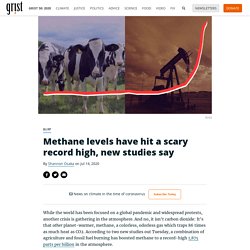
And no, it isn’t carbon dioxide: It’s that other planet-warmer, methane, a colorless, odorless gas which traps 86 times as much heat as CO2. According to two new studies out Tuesday, a combination of agriculture and fossil fuel burning has boosted methane to a record-high 1,875 parts per billion in the atmosphere. If unabated, the researchers warn, methane emissions could push the planet toward a world heated up by 3 to 4 degrees Celsius, one of the worst-case scenarios for global warming. In the race over how to lower global greenhouse gas emissions, methane — a carbon atom joined to four hydrogen atoms — is often left out of the conversation.
Hydrates de méthane. L’administration Trump veut alléger le contrôle des émissions de méthane Humans Are Causing 1 Million Species To Go Extinct. Here Are 3 Ways We Can Still Save Them. Européennes : Didier Porte a regardé les clips de campagne. Si, comme beaucoup, vous ne faites plus que des cauchemars sans surprise, qui ne vous réveillent plus en hurlant, le dos glacé de peur, les dessins de Laurie Lipton vont repeupler vos nuits et vos jours.

Je dis « repeupler » pour vous ménager, mais le vrai mot est « hanter ». Au bureau, en famille, en vacances, rien ne sera tout à fait comme avant, car Laurie Lipton a trouvé le moyen de fendre cette armure molle de banalité qui nous sert aujourd’hui d’uniforme. Il y a vingt ans, Cornelius Castoriadis parlait d’une « montée de l’insignifiance » pour qualifier l’effet du grand bond en arrière néolibéral. Le temps lui donne raison, mais cette médiocratie ne se limite pas au champ politique et intello-médiatique. Scientists are baffled by a giant spike in this greenhouse gas (it’s not CO2) The unexpected culprit that could throw a wrench in the world’s efforts to stop climate change?
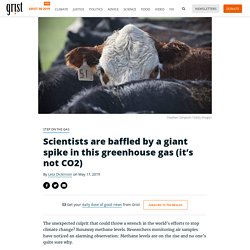
Runaway methane levels. Researchers monitoring air samples have noticed an alarming observation: Methane levels are on the rise and no one’s quite sure why. NOAA’s Earth System Research Laboratory scientists have been analyzing air samples since 1983. Once a week, metal flasks containing air from around the world at different elevations find their way to the Boulder, Colorado, lab. Shell to Trump administration: Regulate us already. La hausse rapide du méthane alarme les climatologues. La quantité de méthane dans l’atmosphère augmente de façon extrêmement rapide.
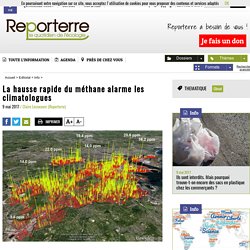
Bien plus que prévu par les scientifiques. Un article publié en avril dans le journal Atmospheric Chemistry and Physics par un comité de 72 chercheurs fait état de cette augmentation inquiétante et de ses causes. Cette publication fait suite à deux articles publiés coup sur coup en décembre 2016 par la même équipe : l’un dressait l’inventaire mondial du méthane sur la période 2000-2012 tandis que le deuxième s’inquiétait du rôle croissant du méthane dans le changement climatique. Greenhouse Gas Regulations Of Methane May Be First To Be Repealed. A natural gas drilling rig's lights shimmer in the evening light near Silt, Colo.
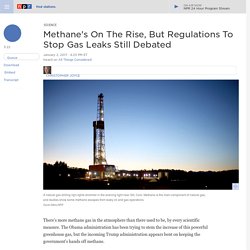
Methane emissions are racing toward nightmare status. Concentrations of the potent greenhouse gas rose faster and faster in the last decade, and particularly in the last two years, according to two new studies.

“If methane keeps going up, we could easily see a degree Fahrenheit increase, independent of CO2,” by the end of the century says Stanford earth scientist Robert Jackson, a coauthor of both studies. “That would be a worst-case scenario.” We need to find a better way to measure methane. Friends of the Earth. Methane is leaking out all over the damn place, thanks to the oil and gas industry. Methane, the second most common greenhouse gas emitted by the U.S., is a scary, scary thing.

Thanks to two new studies, we just found out a bit more about how, through drilling for oil and gas, it leaks into the air. Compared with CO2, methane is frighteningly potent — it’s 86 times more effective at trapping heat than CO2 over a 20-year time period. Even though the EPA estimates that methane is only 9 percent of the greenhouse gas cocktail the U.S. is tossing into the sky, the Environmental Defense Fund estimates that methane is responsible for around 25 percent of the human-made global warming we’re experiencing.
Frackers are flooding the atmosphere with climate-warming methane. The free pass that frackers and natural-gas handlers have gotten on their climate-changing methane emissions is really starting to stink to high hell.

We told you in February about the results of a meta-analysis of 20 years worth of scientific studies, which concluded that the EPA underestimates the natural-gas industry’s climate impacts by 25 to 75 percent, due to methane leakage from its gas drilling operations and pipelines. Climat: alerte au méthane. « La responsabilité du méthane dans le réchauffement n’est pas actuellement de l’ordre de 15% (...) mais plutôt du double », ont constaté Benjamin Dessus et Bernard Laponche à la lecture du résumé du rapport du Giec qui vient de paraître.
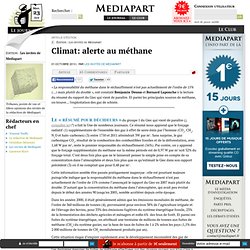
Et parmi les principales sources de méthane, on trouve... l'exploitation des gaz de schiste. Le « résumé pour décideurs » du groupe 1 du Giec qui vient de paraître (à consulter ici) a fait la Une de nombreux journaux.